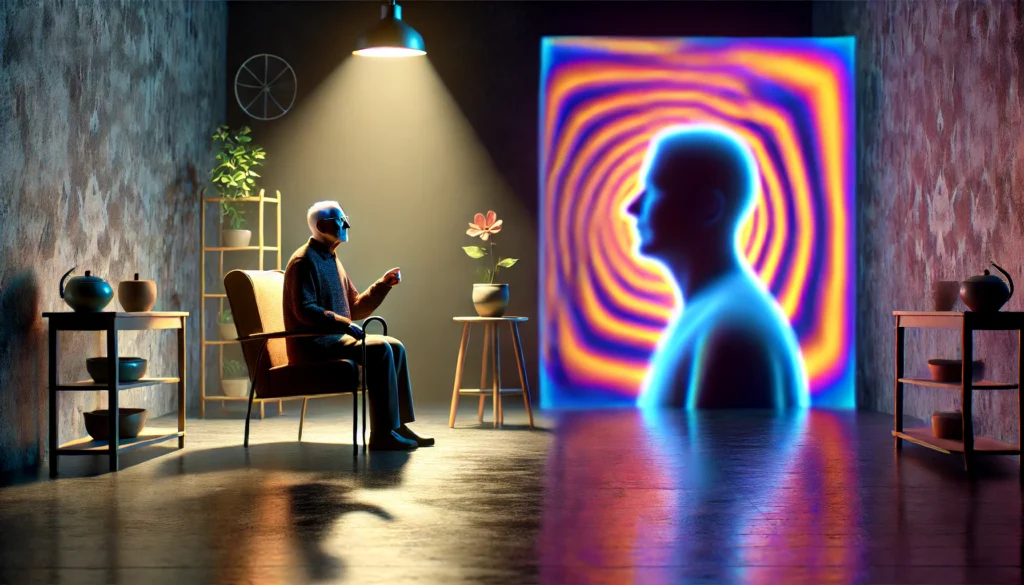Alzheimer’s disease, a progressive neurodegenerative disorder, is most commonly associated with memory loss and cognitive decline. However, many people are unaware that it can also impact vision. Understanding the visual complications associated with Alzheimer’s can enhance early detection, improve patient care, and support overall quality of life. In this article, we will delve into the connections between Alzheimer’s and vision problems, explore early signs, and provide practical advice for caregivers and health professionals.
You may also like: Tips to Improve Low Average Memory Performance
The Connection Between Alzheimer’s and Vision
Alzheimer’s disease affects the brain’s ability to process visual information rather than the eyes themselves. This distinction is crucial; although an individual’s eyesight may remain unchanged, their brain’s interpretation of visual data can be compromised. This deterioration can lead to a range of vision problems, which can manifest in several ways:
How Alzheimer’s Alters Visual Processing
The brain is a complex organ where different parts work together to interpret visual information. In Alzheimer’s, specific brain regions like the occipital lobe degenerate, impairing the brain’s ability to process and make sense of visual stimuli. This can lead to a disconnect between seeing an object and understanding what it is.
Difficulty with Depth Perception
Patients may struggle with judging distances, which can affect their ability to navigate stairs or reach for objects. This issue arises because the brain’s depth perception capabilities are compromised, making it difficult to accurately gauge spatial relationships. As a result, everyday tasks such as walking down a flight of stairs or reaching for a cup can become daunting challenges.
Trouble Recognizing Faces and Objects
Alzheimer’s can disrupt the brain’s ability to identify familiar faces or everyday objects, impacting social interactions and daily routines. This can lead to social withdrawal as patients find it increasingly difficult to recognize even close family members or friends. The inability to correctly identify objects can also hinder one’s ability to perform simple tasks, contributing to a loss of independence.
Color and Contrast Sensitivity
Changes in color perception and reduced contrast sensitivity can make it challenging for patients to distinguish between similar colors or see clearly in low-light conditions. This can complicate tasks such as choosing matching clothes or navigating dimly lit environments. The brain’s impaired processing of visual contrasts can also make reading and watching television more difficult.

Early Signs of Vision Problems in Alzheimer’s
Identifying vision problems early in the course of Alzheimer’s is vital for timely intervention and support. Here are some early signs to watch for:
Changes in Eye Appearance
While Alzheimer’s doesn’t directly alter the eyes’ physical structure, subtle changes might be observed. Some individuals report that their eyes “look different,” which can be an early indicator that the brain’s visual processing is impaired. These changes may be subtle and not immediately noticeable, often requiring close observation or a professional assessment to detect.
Unusual Visual Experiences
Patients may experience “weird” visual disturbances, such as seeing objects that aren’t there or misinterpreting shadows and reflections. These hallucinations can be distressing and may indicate early Alzheimer’s. Often, these experiences are a result of the brain misinterpreting visual inputs, leading to confusion and anxiety for the patient.
Navigational Challenges
As Alzheimer’s progresses, patients may struggle to navigate familiar environments. This difficulty can stem from impaired depth perception, reduced spatial awareness, and trouble interpreting visual cues. Such challenges might manifest as getting lost in one’s own home or being unable to find commonly used items, increasing reliance on caregivers.
Behavioral Changes Related to Vision
Patients may exhibit behaviors such as hesitancy in movement or avoiding certain areas due to visual confusion. These behaviors can be early signs of visual processing issues, prompting further investigation into potential cognitive decline.
Visual-Spatial Disorientation
Visual-spatial disorientation can cause difficulty in understanding spatial relationships, making it hard for patients to orient themselves in a room or understand maps. This disorientation can lead to increased frustration and anxiety when trying to perform tasks that require spatial awareness.
How Alzheimer’s Affects Vision
The visual processing centers in the brain, particularly the occipital lobe, are responsible for interpreting the images received from the eyes. In Alzheimer’s patients, the degeneration of these brain regions can lead to a variety of visual disturbances.
Visual Agnosia
Visual agnosia is the inability to recognize objects or people despite having intact vision. This condition occurs when the brain’s pathways that process visual information are disrupted. In Alzheimer’s, visual agnosia can make it difficult for patients to recognize loved ones or identify everyday items. The experience can be profoundly isolating, as familiar environments and people become unrecognizable, adding to the emotional burden of the disease.
Impaired Depth Perception
The brain’s ability to perceive depth relies on complex visual processing. Alzheimer’s can interfere with this function, resulting in difficulty judging distances. Patients may find it challenging to walk on uneven surfaces, navigate stairs, or pour liquids without spilling. This impairment increases the risk of falls and injuries, necessitating enhanced safety measures in the living environment.
Contrast Sensitivity and Color Perception
Alzheimer’s can impair the brain’s ability to distinguish between different shades and colors, complicating daily tasks like dressing or cooking. Reduced contrast sensitivity can also make it difficult to see in dim lighting or discern objects against similar backgrounds. This visual impairment can affect a patient’s ability to engage in activities they once enjoyed, such as painting or gardening.
Visual Field Deficits
Some Alzheimer’s patients may experience visual field deficits, where parts of their field of vision are missing or distorted. This can lead to accidents, such as bumping into objects or people, as the brain fails to accurately process the entire visual field.
Perceptual Illusions
The brain may create perceptual illusions, where patients see distorted or exaggerated versions of reality. These illusions can be unsettling and may cause distress, requiring reassurance and support from caregivers.
Practical Strategies for Caregivers
Recognizing and addressing vision problems in Alzheimer’s patients can significantly improve their quality of life. Here are some practical strategies for caregivers:
Create a Safe Environment
- Enhance lighting: Ensure that living spaces are well-lit to minimize shadows and improve visibility. Consider using motion-sensor lights for added convenience. Bright, even lighting can help reduce confusion and make it easier for patients to navigate their surroundings.
- Use contrasting colors: Incorporate high-contrast colors in the home to help patients distinguish between objects and surfaces. For example, use a dark-colored placemat under a light-colored plate. This contrast can assist in meal times and other daily activities, making them less frustrating.
- Remove hazards: Eliminate tripping hazards and ensure that walkways are clear. Use non-slip mats and secure handrails for added safety. Regularly check the environment for potential dangers and make necessary adjustments to ensure patient safety.
Simplify Visual Cues
- Label items: Use clear, bold labels to help patients identify objects and navigate their environment. Labels can provide the necessary cues to assist in memory recall, easing the process of finding and using everyday items.
- Minimize visual clutter: Keep spaces tidy and organized to reduce visual distractions. A clutter-free environment can help reduce anxiety and confusion, allowing patients to focus on essential tasks.
- Use simple, recognizable symbols: Incorporate symbols that are easy to understand and recall, assisting patients in navigating and comprehending their environment.
Encourage Regular Eye Exams
Regular eye exams are essential for monitoring vision changes and ensuring that any correctable eye conditions, such as cataracts or glaucoma, are addressed. Eye care professionals can also provide valuable guidance on managing Alzheimer’s-related vision problems. These exams can help differentiate between Alzheimer’s-related issues and other treatable conditions, ensuring appropriate care.

Engage in Vision-Friendly Activities
Encourage activities that are visually engaging yet not overly challenging. Puzzles, painting, and board games can help maintain cognitive function and provide enjoyment.
Provide Emotional Support
Understand that visual impairments can be frustrating and isolating for patients. Offering reassurance and empathy can help alleviate some of the emotional burdens associated with these challenges.
Future Implications and Research
As our understanding of Alzheimer’s disease continues to evolve, researchers are investigating the underlying mechanisms that contribute to vision problems. Advances in neuroimaging and biomarker research may lead to earlier detection and more targeted interventions for these visual disturbances.
The Role of Technology
Innovative technologies, such as virtual reality and augmented reality, hold promise for enhancing the quality of life for Alzheimer’s patients by providing immersive experiences that can stimulate cognitive and visual functions. These technologies can offer simulated environments that aid in maintaining mental agility and visual acuity. Additionally, wearable devices equipped with sensors and artificial intelligence could offer real-time support and guidance for patients experiencing navigational challenges. Such devices may provide alerts or guidance, enhancing safety and independence.
Advances in Neuroimaging
Neuroimaging techniques are becoming increasingly sophisticated, allowing researchers to study the specific brain changes associated with Alzheimer’s. These advancements may lead to better diagnostic tools and more personalized treatment plans.
Potential for New Treatments
As we learn more about the relationship between Alzheimer’s and vision, there is potential for developing treatments that specifically target visual processing deficits. These treatments could improve quality of life and slow the progression of symptoms.
Biomarker Research
Identifying biomarkers that indicate visual processing issues could lead to earlier diagnosis and intervention, potentially delaying the onset of more severe symptoms.

Conclusion
Understanding the connection between Alzheimer’s disease and vision problems is crucial for early detection and effective management. By recognizing the early signs of visual disturbances and implementing practical strategies, caregivers and health professionals can significantly enhance the quality of life for those affected by this challenging condition. Ongoing research and technological advancements offer hope for improving the lives of Alzheimer’s patients and their families in the future. As we continue to explore and innovate, the potential for breakthroughs in care and treatment grows ever closer, promising a brighter future for those impacted by Alzheimer’s.
Further Reading:
Older adults with vision problems face higher dementia risks
Eyesight Problems Linked to Dementia: What That Means For You
Vision problems could be key to early diagnosis of Alzheimer’s disease, study shows
Important Note: The information contained in this article is for general informational purposes only, and should not be construed as health or medical advice, nor is it intended to diagnose, prevent, treat, or cure any disease or health condition. Before embarking on any diet, fitness regimen, or program of nutritional supplementation, it is advisable to consult your healthcare professional in order to determine its safety and probable efficacy in terms of your individual state of health.
Regarding Nutritional Supplements Or Other Non-Prescription Health Products: If any nutritional supplements or other non-prescription health products are mentioned in the foregoing article, any claims or statements made about them have not been evaluated by the U.S. Food and Drug Administration, and such nutritional supplements or other health products are not intended to diagnose, treat, cure, or prevent any disease.


